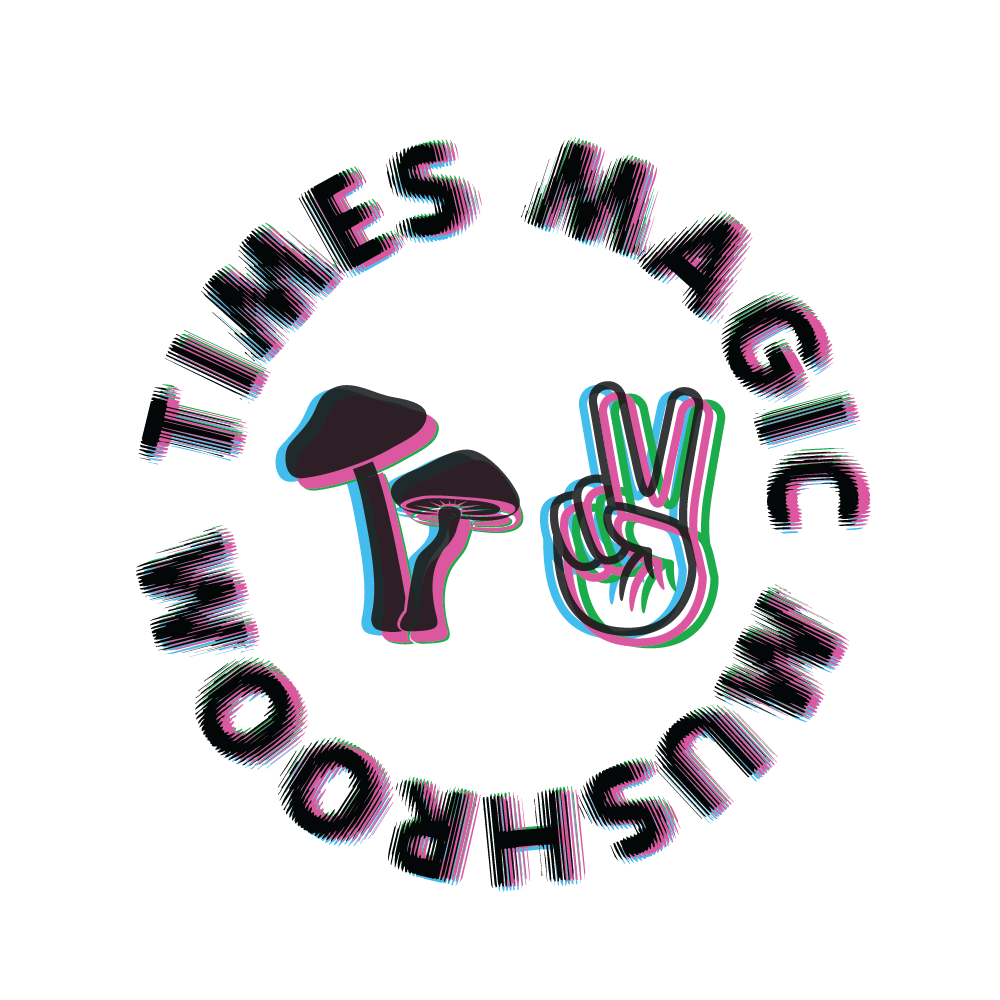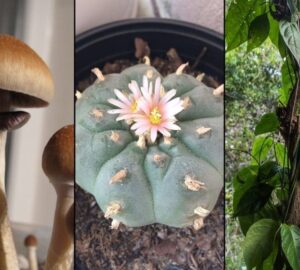Psychedelic art is more than your trippy freshman dorm room poster. In fact, we could argue that all art is “psychedelic” by its own definition (from the Greek to mean “mind-manifesting” or “mind-revealing”). And while the 1960s counterculture canonized a new visual language colored in fluorescent and kaleidoscopic space, we also recognize that the genre extends beyond the Eurocentric media. The earliest visionary art dates back 30,000 years in indigenous shamanic cultures, and Eastern spirituality and its iconography have long provided a roadmap for mind-altering journeys.
Ancient and sacred. Scientific and therapeutic. Cosmic and sublime. Psychedelia defies scope and genre because, like substances, it’s defined by its interpreter. Psychedelic art is doing its job when it expands your inner and outer world by reflecting and refracting it back to you. Look to Bosch’s hellscapes, Dali’s melting clocks, Warhol’s screenprints, and R. Crumb’s comics—even Beeple’s $69 million NFT and this year’s five different van Gogh immersive exhibits—for evidence of psychedelia’s enduring influence on fine art.
Need Access to Shrooms?
Secure your supply with DoubleBlind!
Best Psychedelic Artists on Instagram
Whatever your definition, it’s clear that social media has unlocked a new generation of psychedelic artists (and dealers, but maybe not the art kind), where Instagram grids are transformed into LSD blotters, comic strips, trips incarnate, and so much more. Below are 12 artists who fit the bill for what psychedelic art represents today.
@alexgreycosm
In 1966, 12-year-old Alex Grey focused his science fair project on LSD and the mind-expanding ideas of Timothy Leary. Since, he’s become an icon of the contemporary psychedelic spiritual movement, best known for his “x-ray style” of glowing anatomical human bodies and their multiple layers of reality. You might also recognize his work from the large-scale effigies at Burning Man or album covers and shows from bands like Tool and The Beastie Boys. With 1.3 million followers, Grey is a living legend and among the most influential psychedelic artists of his time.
@geenssarchenti
Visionary artist Geenss Archenti Flores breathes in the strength and richness of daily indigenous life in the high jungle of Peru and breathes out expertly crafted portraits. As technically masterful as they are visually stunning, his shamanic artworks are not merely visual feasts but also deeply reverential. The self-taught artist is inspired by indigenous Amazonian medicine and makes his natural paints, or “medicinal pigments,” out of resins, saps, and fruits extracted from the forests.
@alyssia.strasser
Alyssia Strasser’s featureless “soul bodies” convey both loneliness and hope for healing at the same time—and in neon. Mental health is a major theme for the San Pedro native and multidisciplinary creator, who never fancied herself a fine artist until she began drawing and painting in college. She told LA Weekly that her work explores “facing and overcoming traumatic experiences, leading to healing journeys that ultimately uplift the collective Consciousness.”
How to Grow Shrooms Bundle
Take Both of Our Courses and Save $90!
Learn More
@pupsintrouble
Read: This Trippy New Book Takes You Through Modern Mushroom History—With Cartoons
Illustrator, musician and self-described “comic stripper” Brian Blomerth is the heir apparent to the underground comix scene of the ‘60s and ‘70s. You’ll recognize his signature dog-human hybrids traversing Technicolor scenes rooted in pharmacological history. The Brooklyn-based cartoonist’s Isograph pen and lush watercolors have appeared in The New York Times and Vice. He’s published two educational books on the early days of psychedelic research: Bicycle Day, on the events of April 19, 1943 (the world’s first acid trip); and Mycelium Wassonii, a love story of famed mycologists R. Gordon and Valentina Wasson.
@andersondebernardi
The ayahuasca visions of Anderson Debernardi depict rare cosmic dimensions rendered in sublime landscapes and minutely-detailed imagery. Debernardi uses his art and influence to advocate the preservation of the Amazonian rainforest and its medicinal and visionary plants. His shamanic brushstrokes have been said to open doors to the unseen world. As a globally recognized painter and muralist, he studied under the acclaimed Pablo Amaringo and co-founded the Usko-Ayar Amazonian School of Painting.
@itsanimatedtext
Dank, wholesome memes with a tinge of enlightenment and ‘90s Microsoft Paint fonts? Instant follow. The page’s creator Cat Frazier is a graphic designer known for reviving the perenially nostalgic and unapologetically tacky aesthetic of the early interwebs. AnimatedText began as a Tumblr where Frazier was also hailed as the unofficial GIF queen and advice columnist. On Instagram, she describes the brand as “‘dad jokes’ if your dad was a black lesbian” and posts self-deprecating original content that we all wish we were clever enough to come up with ourselves. Plus it just looks really cool.
@gnyangou
Read: From Jay-Z to Iboga: How this Celebrity Painter Found his (True) Calling
More than a master of spray paint art, Chor Boogie is a truth-teller. The California native’s art and his personal story are punctuated by drug addiction, critical acclaim, relapse, celebrity, and his African heritage and its ancestral medicine, iboga. With raw surrealism and clever command of color and signage, Boogie has attracted fans and institutions like Google, Olympic Games, Jay-Z, Hugh Heffner, and Rage Against the Machine, among others. Today, his art is inspired by the healing wisdom of indigenous Bwiti traditions and laces traditional African imagery with elements of his iboga visions.
@nickwpotts
Sydney-based Nick Potts calms the mind and cleanses the feed in subdued pastels and geometric dreamscapes. His distinct style stands on the shoulders of ‘70s groovy psychedelia. Still, there’s an undeniable contemporary perspective redolent of Venice Beach or Joshua Tree—which is to say, it looks retro and modern at the same time. Works like “Butterfly Tree,” “Rainbow Highway,” and “Crystal Feeling” explore the intersection between spirituality, and esotericism, all with a deep reverence for Mother Nature and other dimensions.
@slimyoddity
The mission of this art collective is to wear love and light on your sleeve. The brand distills timeless truths in the form of psychedelic and enlightened cartoons, books, apparel, and plenty of phone cases. The medium is the message, which they say is “to be a beacon of positive vibes wherever the flow of creativity takes them in Life.” Whether you need daily affirmations in your timeline or on a comfy rainbow blanket, Slimy Oddity has a home for every ineffable truth.
@luistamani.official
Read: A Brief Heritage of Ayahuasca Art
Eschewing labels, Luis Tamani describes himself plainly as a painter from the Peruvian Amazon; his work fills in the rest. Steeped in a magical and multi-dimensional style, Tamani portrays the ecstatic states, visions, and flights of imagination he’s experienced under the influence of sacred medicine plants. He’s a formally trained artist who’s exhibited across the world, yet his work retains a deep communion with his ancestral bonds that interconnect humans with plants and animals. His art is at once a tribal narrative and a way to honor spiritual forces.
@youngmer
What makes a work of art psychedelic, exactly? Art can be beautiful, funny, thought-provoking, healing—and it can also be activism. Mer Plucks Flowers Young, a descendant of Chichimeca and Apache tribes, is an artist and activist focused on BIPOC storytelling, land stewardship, and environmental justice. With her art, Young hopes to “inspire, celebrate and elevate indigenous and native cultures and to bring about change within Brown and Black communities.” Grayscale portraits and colorful landscapes are collaged with surreal pastel skies, each element carefully selected out of respect to the cultural traditions of those honored in each piece.
@tyler_spangler
The psychedelic stream of consciousness of Tyler Spangler sometimes manifests as motivational posters, at times in artsy prints, and other times by macabre GIFs. Whatever the flavor of the day, the graphic designer is best known for his digital collages that fuse catchphrases and perception with a massive injection of color. An art school dropout, psychology grad, and illegal punk show organizer, Spangler’s nabbed clients from Adobe and United Nations to Gucci and Nike. It’s an intoxicating aesthetic grounded in pop art, mental health, Surrealism, Dada, and humor.
We started DoubleBlind two years ago at a time when even the largest magazines and media companies were cutting staff and going out of business. At the time we made a commitment: we will never have a paywall, we will never rely on advertisers we don’t believe in to fund our reporting, and we will always be accessible via email and social media to support people for free on their journeys with plant medicines.
To help us do this, if you feel called and can afford it, we ask you to consider becoming a monthly member and supporting our work. In exchange, you’ll receive a subscription to our print magazine, monthly calls with leading psychedelic experts, access to our psychedelic community, and much more.
DoubleBlind Mag Read More



